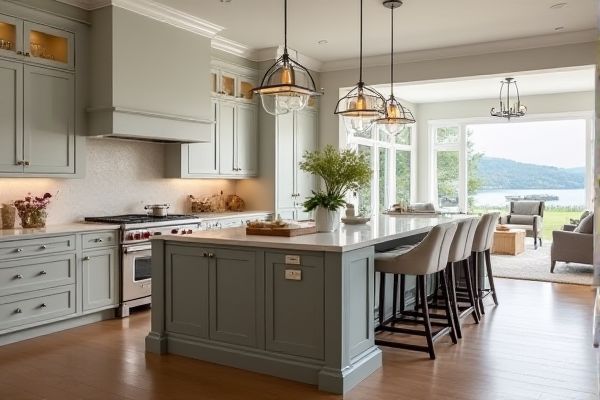
Freestanding kitchen islands offer flexible placement and easy installation, while built-in islands provide a seamless, custom design that maximizes space and functionality in your kitchen. Explore the advantages and considerations of each option to determine which island best suits your home's style and your cooking needs.
Table of Comparison
| Feature | Freestanding Island | Built-in Island |
|---|---|---|
| Installation | Easy, no permanent attachment | Requires professional installation, fixed position |
| Mobility | Movable, flexible layout options | Stationary, part of kitchen structure |
| Customization | Limited; based on size & style available | Highly customizable; materials & design |
| Storage | Limited storage options | Ample integrated storage and cabinets |
| Cost | Generally lower cost | Higher cost due to construction and design |
| Uses | Extra prep or serving space | Prep, storage, seating & appliance integration |
| Space Requirement | Requires less space, ideal for smaller kitchens | Needs more space, suited for large kitchens |
| Design Impact | Casual, versatile style | Sleek, cohesive kitchen look |
Introduction to Kitchen Islands
Kitchen islands serve as multifunctional workspaces, enhancing both the design and utility of your cooking area. Freestanding islands offer flexibility in placement and often include wheels for mobility, making them ideal for adaptable kitchen layouts. Built-in islands are integrated into the cabinetry, providing seamless storage solutions and a permanent, cohesive look that maximizes kitchen efficiency.
What is a Freestanding Island?
A freestanding island is a standalone kitchen unit that is not attached to any walls or cabinetry, offering maximum flexibility in placement and design. It typically features accessible sides, allowing you to customize seating, storage, and appliances on all four edges. This type of island enhances kitchen flow and can serve as a focal point while providing ample workspace for cooking and entertaining.
What is a Built-in Island?
A built-in island is a fixed kitchen fixture seamlessly integrated into cabinetry and countertops, designed to provide additional workspace and storage while complementing the overall kitchen layout. Unlike freestanding islands, built-in islands are custom-built to match the kitchen's style, often incorporating appliances, sinks, or seating areas. This integration optimizes space efficiency and enhances the kitchen's aesthetic cohesion.
Design Flexibility and Style Comparison
Freestanding islands offer greater design flexibility, allowing for easy rearrangement and customization to fit various kitchen layouts and styles, from modern to traditional. Built-in islands provide a cohesive, integrated look that can include fixed cabinetry, appliances, and seating, creating a permanent focal point with a streamlined design. Choosing between the two depends on whether adaptability or seamless integration aligns best with your kitchen's aesthetic and functional needs.
Space Requirements and Layout Considerations
Freestanding kitchen islands offer flexible placement options and require less permanent space, making them ideal for open floor plans or smaller kitchens where mobility is essential. Built-in islands demand more dedicated space due to their fixed installation and integration with cabinetry, often shaping the kitchen's overall layout and workflow. Assessing your kitchen's dimensions and traffic flow helps determine if a freestanding or built-in island best optimizes your space requirements and functional needs.
Installation Process and Cost Differences
Freestanding islands offer simpler installation, often requiring no professional help, making them a cost-effective choice for quick kitchen upgrades. Built-in islands demand complex construction, plumbing, and electrical work, significantly increasing installation time and expenses. Your decision should weigh the convenience and lower upfront cost of freestanding options against the custom fit and potential added value of a built-in island.
Storage and Functionality Features
Freestanding kitchen islands offer flexible storage options with open shelving, cabinets, and sometimes drawers, making them ideal for modular layouts and easy relocation. Built-in islands typically provide more integrated and customized storage solutions, such as deep drawers, pull-out trays, and dedicated compartments tailored to the kitchen's design. Functionality in built-in islands often includes added features like built-in appliances and plumbing hookups, whereas freestanding islands prioritize versatility and simpler installation.
Mobility and Adaptability: Pros and Cons
Freestanding kitchen islands offer superior mobility, allowing homeowners to easily rearrange or relocate the island to suit changing kitchen layouts or multifunctional uses. Built-in islands provide a more permanent and stable solution but lack adaptability, as they are fixed and integrated into the kitchen design, making remodeling more complex and costly. While freestanding islands enhance flexibility and accessibility, built-in islands generally offer increased durability and additional storage due to their fixed installation.
Maintenance and Durability
Freestanding islands offer easier maintenance due to their accessible sides, allowing you to clean thoroughly without obstruction. Built-in islands are typically more durable, as they are anchored securely to the floor and cabinetry, reducing the risk of movement or damage over time. Choosing between the two depends on your preference for maintenance convenience versus long-term structural stability.
Which Kitchen Island is Right for You?
Freestanding kitchen islands offer flexibility and easy relocation, ideal for smaller spaces or renters seeking versatile kitchen layouts. Built-in islands provide customized storage and seating integrated with cabinetry, suitable for permanent kitchens emphasizing design cohesion and durability. Consider your kitchen size, usage frequency, and design preferences when choosing between the mobility of freestanding islands and the tailored functionality of built-in islands.
 homyna.com
homyna.com